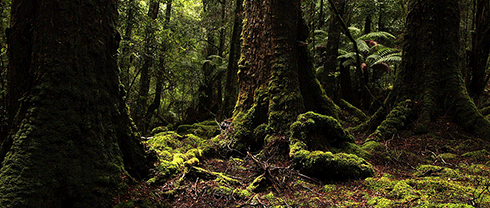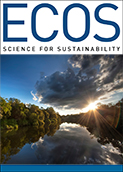
|
Published: 15 December 2014
‘Primary’ forests? Yes, there is a difference – and we need them more than ever
What often gets lost in the public debate about forests is the fact that they are not all the same. This is not just a rhetorical point. The world’s ‘primary’ forests – those barely touched by industrial human activity – naturally sequester and store vast amounts of carbon from the atmosphere; are home to species found nowhere else; are a source of abundant freshwater; and provide sustainable livelihoods for forest-dwelling Indigenous communities.

|
|
Three ancient beech trees in an old-growth forest in Tasmania: most of the world’s forest carbon resides in the woody biomass of large old trees. In fact, primary forests store 30–70 per cent more carbon than plantation and regrowth forests. Credit:
©Penny Whetton
|
It is these primary forests – and not secondary (regrowth or plantation) forests – that will do the heavy lifting in helping protect the planet from dangerous climate change and conserving biodiversity over the coming decades.
Humanity has already wiped out large tracts of forests. About 35 per cent of the world’s natural forest cover (61.5 million square kilometres, or sq km) has been lost to agriculture; in Australia, the figure is closer to 50 per cent.
Of the remaining 40 million sq km of global forest, some 57 per cent is subject to industrial logging or designated for multiple uses, including wood production; 7 per cent is plantation; and around 36 per cent (14.5 million sq km) is primary forest.
Ecologists define primary forest as that which naturally regenerates from native species, where there are no clearly visible indications of industrial human activity and where ecological and evolutionary processes have not been significantly disrupted.
A challenge for all nations, rich and poor
Large, unbroken expanses of primary forest in blocks of 500 sq km or more are called intact forest landscapes. About 13 million sq km of intact forest landscape remains on the planet, with about 50 per cent occurring in boreal forests, 46 per cent in tropical forests, and 3 per cent in temperate forests.
Another 1.4–3.5 million sq km of primary forest occurs in smaller blocks of less than 500 sq km. In otherwise extensively cleared and fragmented bioregions, these smaller areas are important as they represent the best of what’s left. As well as being needed for landscape restoration, they also provide the last habitat refuge for many species.
Almost all (98 per cent) primary forest occurs in 25 countries, with half occurring in five developed countries – USA, Canada, Russia, Australia and New Zealand – and the rest in developing countries. Alarmingly, only 22 per cent of the world’s primary forest is found in official protected areas, which represents just 5 per cent of pre-agriculture natural forest cover.
Over the past 12 years, the area covered by natural forests globally has been reduced by an estimated 22.3 million sq km. From 2000 to 2010, logging and other human activity accounted for the loss of almost half a million square kilometres of primary forest. However, this is likely to be a significant underestimate, as it excludes some high-forest-cover nations such as Democratic Republic of the Congo, which lost 2 per cent of its more than one million square kilometres of primary forest during that period.
While developing countries are often criticised for poor forests management, Australia also has work to do. Globally, the most cleared and degraded forest type is temperate forest such as that found in the eucalyptus and rainforests of southern NSW, Victoria, Tasmania and WA. That makes Australia’s remaining primary forest blocks of temperate forests of international significance.
Services delivered by primary forests
Primary forests have characteristics not found in logged and degraded secondary forests dominated by ‘baby’ trees. The former are usually characterised by large old trees and coarse woody debris, and harbour a much greater variety of local native species, especially the larger intact forest landscapes.
Intact forest is critical for the maintenance of native species diversity, including life-forms found only in large areas of primary forest. Biodiversity generally declines as you move from old-growth forest to secondary forest, agroforestry, plantations, arable crops, and finally pasture. If we continue to allow primary forest to be logged, degraded and cleared, we will lose significant and irreplaceable wildlife habitat for the many plant, animal and microbial species that depend on these forests for their survival.
Catastrophic as it is, biodiversity loss is not the only grave risk facing humanity this century from primary forest loss. Many people do not realise that about one-third of the accumulated CO2 in the atmosphere due to human activities is from deforestation and degradation. The other two-thirds is from fossil fuel use.
Currently, total annual global greenhouse gas emissions (76 per cent of which are CO2) are around 49 billion tonnes, with 64 per cent being from fossil fuel use and 24 per cent (12 billion tonnes) from land use impacts. The world’s forest biomass contains about 289 billion tonnes of carbon, with as much again locked away in other forest ecosystem ‘pools’ such as dead biomass and soil. Most of this carbon resides in the woody biomass of large old trees. This is largely why primary forests store 30–70 per cent more carbon than plantation and regrowth forests. Thus their ongoing loss will make it all the harder for the world’s nations to meet national greenhouse gas mitigation targets and keep climate change to a more manageable level.
Scientists estimate that complete deforestation by 2100 could increase atmospheric concentrations of CO2 by 130–290 parts per million (ppm). Current atmospheric CO2 concentration is around 400 ppm. The upper limit that would still allow a reasonable chance of limiting global warming to 2oC above pre-industrial levels is about 500 ppm, so even a level of 530 ppm would make the planet a more dangerous and less habitable home for humans and many other species.
Another ‘ecosystem service’ provided by pristine forests is that their catchments yield a high-quality water supply. This is why the upper catchments of Melbourne’s water supply have been protected for over 100 years from extractive industries and other damaging activity.
In many regions of the world, primary forests also provide a home to Indigenous people, who depend on them for their traditional cultural practices and sustainable livelihoods.
Valuing these services
Ecologists, economists and policy-makers have been showing interest in the concept of environmental accounting and payment for ecosystem services. This can provide communities, and society in general, with more sustainable policies compared to those based on traditional economic valuation. For example, environmental accounting and ecosystem service payments can provide additional sources of income for land stewards and custodians undertaking conservation management activities.
However, we are yet to see the special qualities and ecosystem services of primary forests recognised in policy negotiations involving nations signatory to the Convention on Biological Diversity (CBD) and the UN Framework Convention on Climate Change (UNFCCC).
Under the UNFCCC, land-sector carbon-mitigation policy is covered under Reducing Emissions from Deforestation and Forest Degradation in Developing Countries (REDD+) and under Land Use, Land-Use Change and Forestry (LULUCF) for developed countries.
What is not so widely recognised is that the key mitigation value of primary forests resides in the significant carbon stocks built up over hundreds or thousands of years. The idea that replacing primary forests by plantations or regrowth forests on the basis these will create carbon ‘sinks’ is profoundly incorrect, as it fails to recognise the emissions released from depleting the primary forests’ carbon stocks.
Avoiding loss altogether is the key
This is where the principle of ‘avoided loss’ becomes important. Many national and international policies seek to reduce the rate at which biodiversity is lost and ecosystems are cleared and degraded. But because we are causing problems faster than we can fix them, we need to avoid losing primary forest altogether, rather than merely reducing rates of loss.
The world’s primary forests face increasing pressures from the growing demand for food, towns and cities, fibre and energy to service a human population predicted to surpass 9 billion by 2050 – not to mention impacts predicted from a rapidly changing climate.
So the world’s countries, developed and developing, will need to support policies in UNFCCC and CBD negotiations that protect remaining primary forests, and then follow up with action in their own jurisdictions. These policies should ensure that investment is directed towards conservation action that avoids harm to primary forests.
Formally recognising primary forest as a distinct type would be an important step in developing programs that provide payments for ecosystem services based on the avoided loss principle.
The door to saving our primary forests is still open, but will close rapidly in the coming years. The reality is that, while primary forests are quickly depleted of biodiversity and carbon, it can take hundreds to thousands of years to achieve full recovery; and in many cases full restoration is infeasible.
Professor Brendan Mackey is Director of the Griffith Climate Change Response Program, Griffith University, Queensland. He has a special interest in the science and policy of ecosystem-based adaptation and mitigation and related public policy issues. Prof Mackey is a member of the international governing Council of the International Union for Conservation of Nature (IUCN). He has written over 150 academic publications including journal articles, books and books chapter.
More information
Food and Agricultural Organization (2010) Key findings: newest information and knowledge about the world’s global forest resources. FAO Assessment.
Keith H, Lindenmayer D, Mackey B, Blair D, Carter L, McBurney L,Okada S, and Konishi-Nagano T (2014) Managing temperate forests for carbon storage: impacts of logging versus forest protection on carbon stocks. Ecosphere 5(6), Article 75, 1–34.
Mackey B, DellaSala DA, Kormos C, Lindenmayer D, Kumpel N, Zimmerman B, Hugh S, Young V, Foley S, Arsenis K, and Watson JEM (2014) Policy options for the world’s primary forests in multilateral environmental agreements. Conservation Letters, published online August 2014.
Mackey B, Prentice IC, Steffen W, House JI, Lindenmayer D, Keith H and Berry S (2013) Untangling the confusion around land carbon science and climate change mitigation policy. Nature Climate Change 3, 552–57.
IPCC (2014) Climate Change 2014 – Mitigation of Climate Change. Contribution of Working Group III to the Fifth Assessment Report of the Intergovernmental Panel on Climate Change [Edenhofer O, R Pichs-Madruga, Y Sokona, E Farahani, S Kadner, K Seyboth, A Adler, I Baum, S Brunner, P Eickemeier, B Kriemann, J Savolainen, S Schlömer, C von Stechow, T Zwickel and JC Minx (eds)]. Cambridge University Press, Cambridge, United Kingdom and New York, NY, USA. (Chapter 5 – Drivers, Trends and Mitigation)



